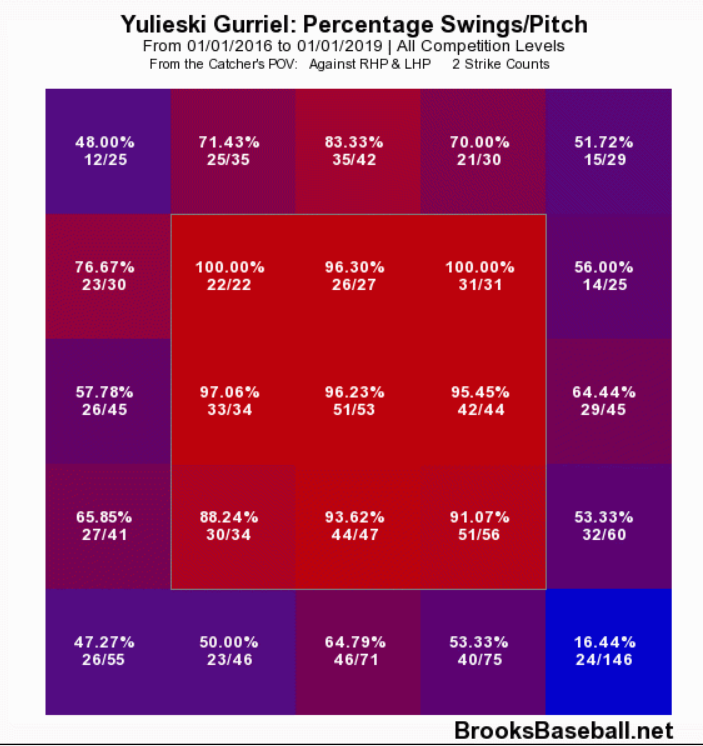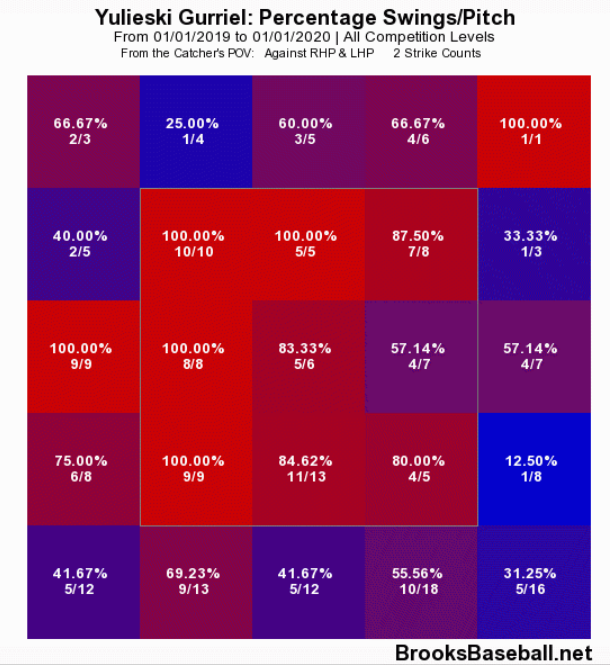Friend, you’re a baseball fan. You don’t need me to tell you that the Astros are great, because you already know it. You probably know they’re playing .650 baseball so far this year. If you look at their run differential, you might notice that their Pythagorean record is actually better than their record — they “should” have one more win based on their run differential. Heck, if you look at BaseRuns standings, which look at underlying production rather than runs, they “should” have three more wins. Their offensive and defensive statistics work out to a projected .700 winning percentage. That’s a 113-win pace for a full season, and playing well enough to have a 113-win season with neutral luck is outrageous.
You also don’t need me to tell you that the Astros offense is great. Their team batting line so far this year is .275/.349/.488, good for a 126 wRC+. If the entire Astros offense were a player, they’d be a top-60 hitter in all of baseball. Not the Astros starters. Not qualifying Astros batters. The entire team, backup catchers and minor league call-ups and all, is producing slightly better than Ronald Acuna this year. Ronald Acuna signed a $100 million contract this year and people protested how underpaid he is. Again, the entire Astros team is hitting like that.
The thing is, though, you also already knew that. Astros offense superlatives and near-superlatives are endless. They strike out less than any team but the Angels. They hit for more power than any team other than the Twins. They get on base more than any team in baseball. In a stadium that doesn’t help offense, they’re scoring 5.2 runs a game, with underlying statistics that look like they should be scoring 5.5. They’re hitting for the highest batting average in baseball and simultaneously have the third-most home runs, all without having played the Orioles. Average or power? Porque no los dos?
Yes, finding new and interesting things to say about the Astros offense is challenging. I’m going to try, though. One of the strengths of this Astros team is their incredible star power. George Springer is vying with Mike Trout for the most WAR in the American League, with a 172 wRC+ that’s sixth in baseball. Alex Bregman is replicating his breakout 2018 — a 152 wRC+ with more walks than strikeouts. He’s running a BABIP of .237 despite an xBABIP of .316 — he could actually be due for some positive regression! Michael Brantley has turned the Astros’ one lineup hole from 2018, left field, into a point of strength. He’s striking out a what-are-you-talking-about 9.5% of the time while hitting for power on his way to a 144 wRC+.
Those three players have been worth a combined seven wins above replacement. They have a collective 156 wRC+. The only teams with a better-hitting top three (minimum 100 PA per batter) are the Dodgers and the Cubs (the Pirates are a close fourth). The Astros’ stars, in other words, are the envy of nearly all of baseball. As an aside, the best three Marlins batters have put up a cumulative 99 wRC+. What’s an article about a great offense without a fun fact about the inverse?
That’s all well and good — the cream of the Astro crop is incredible. You probably knew that, because all three players are drawing headlines. Great, cool, amazing. What you might not know, though, is that the rest of the offense is incredible as well. Think of it this way: George Springer just went on the 10-day IL with a hamstring strain. How will the Astros offense fare without him? Well, the rest of their team has combined for a 122 wRC+ this year, which would be the second-best batting team in the majors, behind only the equally hot Twins.
We can take this further. Let’s get rid of Bregman as well. Without Bregman and Springer, the Astros would have a 116 wRC+, good for the fifth-best non-pitcher wRC+. Two MVP candidates down, the Astros are nipping at the Cubs’ heels for fourth-best offense in baseball. Heck, let’s go further and take out Brantley. With all three of the Astros’ top trio removed (and again, they’re one of the best groups in baseball), the remaining Astros have compiled a 112 wRC+ this year. That batting line would be fifth-best in baseball, just ahead of the Braves. The Braves have a dynamic offense, with sensational young talent backed by Freddie Freeman. That’s how good the Astros are after you get rid of three MVP candidates. If that doesn’t make much sense to you, well — good. It’s outrageous!
We can go further. The weighted wRC+ of the Astros’ 4th-6th best hitters (Carlos Correa, Jake Marisnick, and Robinson Chirinos) is 137. Want to replace Marisnick’s small sample with a larger sample of a worse batting line from Josh Reddick? It’s still 133. As you might expect, this group of 4th-6th offensive options is the best such group in baseball. The Rangers’ trio of Logan Forsythe (not as washed up as I expected), Elvis Andrus, and Danny Santana are within striking distance at a 127 wRC+, but no one is particularly close to matching the Astros’ trio. Heck, this Astros group is better than 15 other teams’ top three hitters, even if you use the lower-wRC+ Reddick group. The Astros’ mid-tier guys are simply unlucky — they’d be the best three guys on plenty of teams.
Let’s get really crazy now. Let’s exclude the six best hitters from the Astro lineup. I’m cutting Reddick out here in the interest of making the remaining lineup score as poorly as possible. With none of their top six hitters, the Astros have a remaining team wRC+ of 98. The back half of the team, the part that is largely comprised of fifth outfielders and utility infielders and backup catchers, is almost as good at batting as the league as a whole.
If that sounds absurd, it’s because it is. There’s an MVP candidate having a so-so year in this group (Jose Altuve and his 117 wRC+), which is only notable because it’s not one of the best eight batting lines on the team. Aledmys Diaz has a 118 wRC+, which would rank among the top 10 second basemen in baseball if he could get on the field enough to qualify. Heck, even Tony Kemp’s 86 wRC+ isn’t too bad — it’s certifiably great for a fifth outfielder, but it’s not even embarrassing for the worst regular starter on a team, which Kemp most emphatically is not.
How stacked is this Astros team? If the top six Astros weren’t allowed to bat and instead of replacing them with minor leaguers, the team filled in the missing plate appearances with the remaining players’ 2019 lines, the team would project to score roughly 4.5 runs a game after accounting for park factors. With the team’s great pitching (3.53 runs per game allowed), their Pythagorean winning percentage would be .611. The hobbled Astros would have the fifth-best Pythagorean winning percentage in baseball. Want it in BaseRuns? That still works out to a .610 expected winning percentage, fourth-best in baseball.
Now, in reality, this is more of a fun fact about the Astros pitching staff than one about their hitters. Replace the historically dominant Astros offense with a sub-100 wRC+ bunch, and the team would still be one of the best in baseball. Their pitching is just that good. But it’s also an Astros offense fun fact because that 100-ish wRC+ team just so happens to be the Astros’ offense after subtracting out their six best hitters in 2019.
Just to drive the point home, here’s a table of the Astros offense, only subtracting out their x best hitters. The distance you have to go down the line to make a bad team is staggering. The Astros minus their top nine hitters would have the same wRC+ as the Indians this year!
Astros Offense, With Missing Persons
| No. of Hitters Removed |
Remaining wRC+ |
| 1 |
122 |
| 2 |
116 |
| 3 |
112 |
| 4 |
106 |
| 5 |
103 |
| 6 |
98 |
| 7 |
92 |
| 8 |
88 |
| 9 |
77 |
The 2019 Astros are an exercise in baseball absurdity. Their best hitters are as good as any team’s best hitters. Their mid-tier hitters are better than a bunch of other teams’ best hitters. Their worst hitters are league average. If it’s hard to wrap your head around how good this team is, that’s reasonable. Teams don’t bat this well for full seasons. Since 1900, the only team with a better league-adjusted full-season line is the 1927 Yankees, who were literally nicknamed Murderer’s Row. Teams that hit like the Astros are dimly remembered myths, not flesh-and-blood modern concerns. That’s not a comparison you can make in your head, most likely, because it isn’t one I can make in mine.
Getting rid of the good players makes a comparison a little more mentally reasonable. Remove three MVP candidates, and the Astros are still one of the best-hitting teams in baseball. Remove three more of the best hitters in baseball, and the dregs of the team still hit like the A’s or the Nationals. So don’t focus on the aggregate line, the pure statistical absurdity of the 2019 Astros. Focus on how well every part of the Astros lineup is hitting, how their utility infielder hits like your All-Star second baseman. This performance almost certainly won’t keep up, but it’s still amazing to marvel at the extent of their excellence in 2019.




